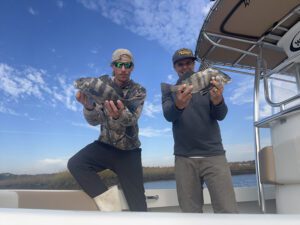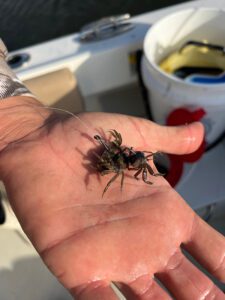Tidelines – December 2023
“Unlike flounder fishing and red drum fishing when you’re targeting that grassline and trying to get your cast to lay right by the grass, the black drum are more down on the transition point of the ledge and not so much on the grass itself. The contour line of that ledge is what they’re hanging on,” Capt. Kaleb Frink, of River Run Fishing Charters out of the Southport/Oak Island area explained to me as we pulled up to our first spot in the Elizabeth River.
By early November, Kaleb is typically targeting speckled trout with slip corks and live shrimp, and black drum happen but happen mostly as bycatch. However, weather and water temperatures are anything but typical these days, so our target species that second week of November was black drum and we were armed with bait shrimp and fiddler crabs, perhaps Kaleb’s last grab of fiddlers for the year.
“We’re fishing this grass point with oysters on it, and the wind and the current blow up and push bait into this elbow in this point,” Kaleb described while organizing the back of the boat by pulling out a couple of rods, the small bucket of fiddlers, and the big block of shrimp. “The drum and other fish stack up in here looking to find that bait, such as shrimp, and I feel like the oysters do a good job of holding them there.”

Capt. Kaleb Frink (left), of River Run Fishing Charters, and Gary Hurley, of Fisherman’s Post, hold up two of the keeper black drum they caught in the Oak Island area using shrimp and fiddler crabs on Carolina rigs.
The water temperature was about 64-degrees, which Kaleb prefers for black drum fishing. Above 70-degrees is typically too hot for specifically targeting black drum, so he focuses on such species as red drum and flounder, and once the water drops below 60-degrees, he switches over to trout. On my Carolina rig, he put three fiddler crabs on the one hook and instructed me to cast near the shallow section of the grassline, where some water was spilling over with the falling tide, but off the bank about 6-feet or so.
I thought I remembered he fished bottom sweepers. I asked, and he explained, “I did fish bottom sweepers a lot, and in certain situations I still do. I’ve come to find that the lighter bottom sweepers do better, but with today’s current, I can’t get away with a 1/2 oz. bottom sweeper. It would roll all over the place, so we’re fishing a Carolina rig with a 3/4 oz. egg sinker and I drop my leader size down to 30 lbs. this time of year.”
Kaleb approved of the location of my first cast, and since he had already told me that he liked the current, the water level, and the wind direction, I optimistically asked another question—what’s the bite going to feel like? “The black drum bite is going to be real slow and lethargic,” Kaleb told me while throwing out his own Carolina-rigged fiddler crabs, “It’ll be a bump, another bump or two, and then you’ll feel the fish pull off with it. He’ll try to leave with it, and that’s when you set the hook.”
On cue, I felt a bump and another bump, and then my line and bait slowly started moving. I set the hook, felt the fish resist for a second or two, and then there was no resistance. The fish was swimming at me, which Kaleb had already told me was characteristic of black drum, so I reeled fast to catch up and came tight again about half way to us. Soon Kaleb’s landing net had our first keeper black drum in the boat.
We decided to forego photos so that we could get baits quickly back in the water. Once again, Kaleb put three fiddlers on my hook, and I did what I do—I asked more questions, this time about multiple fiddlers. “It gives the black drum more to bite on, has a bigger profile, and if you lose one crab, you still have crabs on the hook,” he said. Don’t black drum think it unnatural to see three crabs close together on a hook?

Capt. Kaleb Frink, of River Run Fishing Charters, displays the standard bait tactic he uses for black drum: 2-3 fiddler crabs on a Carolina rig using an Owner Octopus SSW 2/0 and 30 lb. leader.
“If you imagine a bunch of fiddler crabs on a waterway bank and a yacht comes through and sends a big wake that washes a bunch of them out,” he continued, “their first reaction is going to be to grab one another. So I feel like that ball of fiddler crabs is natural. Besides, a fiddler crab in the water is unnatural anyways.” Our spot produced multiple black drum for each of us, including a couple of small reds, and then as fishing goes, the spot stopped producing. We were a victim of the falling tide. The water level was now too shallow, so Kaleb picked up to target a deep hole in an area creek.
On the short run, he continued my education, “I find that these fish are moving from spot to spot. On the higher part of the tide, those fish will be on the grass, but then they drop off into the deeper holes to hangout through the bottom of the falling tide. I think that same school of fish on the grass at the top of a falling tide is going to push into a deep hole on the bottom of a falling tide, or vice versa.”
Yes, the black drum were in the 12-foot hole Kaleb wanted to target. In this locale, they seemed to prefer the shrimp more than the fiddlers, and we also found a wider variety of species. In addition to black drum and smaller reds, we also hooked sheepshead and croakers (but, thankfully, no pinfish).
After this deeper water spot slowed, we finally took our photos and leisurely made way back to the Wildlife ramp. For most of the run, Kaleb continued to share. “The absolute best months are May and October/November,” he offered, “and you want to look for oyster rocks, ledges, and contours. If you’ve got an oyster rock and a mud bottom, chances are there’s going to be black drum there.”
“You also want to fish areas where you’ve caught redfish and flounder in the summer. The black drum are likely to be on that same structure. They’re just doing slightly different things in the same areas.” Capt. Kaleb Frink, of River Run Fishing Charters out of Southport/Oak Island, would love to give you your own personal experience with, and education on, black drum fishing (or on any number of species, including red drum, trout, flounder, sheepshead, etc.). Check him out at www.RiverRunFishingCharters.com, and like me, you, too, can ask him question after question while fighting keeper black drum to the boat. I also suggest putting fish in the cooler, quickly getting baits back out, and finding time for photos when it’s time to head in.





